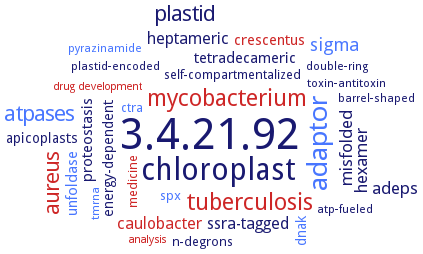3.4.21.92: Endopeptidase Clp
This is an abbreviated version!
For detailed information about Endopeptidase Clp, go to the full flat file.

Word Map on EC 3.4.21.92 
-
3.4.21.92
-
chloroplast
-
adaptor
-
tuberculosis
-
mycobacterium
-
atpases
-
plastid
-
aureus
-
sigma
-
misfolded
-
hexamer
-
adeps
-
ssra-tagged
-
heptameric
-
caulobacter
-
unfoldase
-
proteostasis
-
crescentus
-
tetradecameric
-
energy-dependent
-
apicoplasts
-
dnak
-
self-compartmentalized
-
n-degrons
-
medicine
-
ctra
-
spx
-
atp-fueled
-
pyrazinamide
-
toxin-antitoxin
-
double-ring
-
tmrna
-
plastid-encoded
-
barrel-shaped
-
drug development
-
analysis
- 3.4.21.92
- chloroplast
- adaptor
- tuberculosis
- mycobacterium
- atpases
- plastid
- aureus
- sigma
-
misfolded
-
hexamer
-
adeps
-
ssra-tagged
-
heptameric
- caulobacter
- unfoldase
-
proteostasis
- crescentus
-
tetradecameric
-
energy-dependent
- apicoplasts
- dnak
-
self-compartmentalized
-
n-degrons
- medicine
- ctra
- spx
-
atp-fueled
- pyrazinamide
-
toxin-antitoxin
-
double-ring
- tmrna
-
plastid-encoded
-
barrel-shaped
- drug development
- analysis
Reaction
Hydrolysis of proteins to small peptides in the presence of ATP and Mg2+. alpha-Casein is the usual test substrate. In the absence of ATP, only oligopeptides shorter than five residues are hydrolysed (such as succinyl-Leu-Tyr-/-NHMec, and Leu-Tyr-Leu-/-Tyr-Trp, in which cleavage of the -Tyr-/-Leu- and -Tyr-/-Trp bonds also occurs) =
Synonyms
ATP-dependent caseinolytic protease, ATP-dependent Clp protease, ATP-dependent Clp protease proteolytic subunit 1, ATP-dependent Clp protease proteolytic subunit 2, BsClpP, Caseinolytic protease, CLP, Clp protease, Clp proteolytic subunit, ClpA, ClpAP, ClpAP protease, ClpB, ClpC, ClpC ATPase, ClpC1, ClpCP protease, ClpCP3/R protease, ClpE, ClpP, ClpP Peptidase, ClpP Protease, ClpP protease complex, ClpP1, ClpP1 protease, ClpP1P2, ClpP2, ClpP2 protease, ClpP3, ClpP3/R complex, ClpQ, ClpR, ClpS1, ClpX, ClpX2, ClpXP, ClpXP protease, ClpY, CplC, endopeptidase Clp, endopeptidase Ti, Heat shock protein F21.5, heat-shock protease ClpP, nClpP7, nClpP8, PfClpP, Protease Ti, stress protein G7


 results (
results ( results (
results ( top
top





